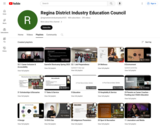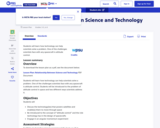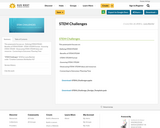
Videos produced by RDIEC. Career Spotlights, interviews, panel discussions, and Employment information.
- Subject:
- Career & Work Exploration
- Practical & Applied Arts
- Material Type:
- Diagram/Illustration
- Author:
- RDIEC
- Date Added:
- 05/06/2024

Videos produced by RDIEC. Career Spotlights, interviews, panel discussions, and Employment information.

In this activity, students will learn how technology can help scientists solve a problem. One of the challenges scientists face with any spacecraft is attitude control. Students will be introduced to the problem of attitude control in space through an experiment using angular momentum, and experience two different ways scientists address this problem. Students begin by discussing the technology(ies) that powers satellites and enable(s) them to move through space. Students then engage in an angular momentum experiment.åÊEstimated cost of this activity does not include the cost of the bicycle wheel for the angular momentum experiment. This activity is one of several in the Swift: Eyes through Time collection available on the Teachers' Domain website.

This collection of 103 individual sets of math problems derives from images and data generated by NASA remote sensing technology. Whether used as a challenge activity, enrichment activity and/or a formative assessment, the problems allow students to engage in authentic applications of math. Each set consists of one page of math problems (one to six problems per page) and an accompanying answer key. Based on complexity, the problem sets are designated for two grade level groups: 6-8 and 9-12. Also included is an introduction to remote sensing, a matrix aligning the problem sets to specific math topics, and four problems for beginners (grades 3-5).

Learn about the physics of resistance in a wire. Change its resistivity, length, and area to see how they affect the wire's resistance. The sizes of the symbols in the equation change along with the diagram of a wire.

This is an activity about image resolution. Learners will recreate a solar image taken by the Solar Dynamics Observatory (SDO) using various sizes of building bricks, and discuss how their recreations relate to image resolution. Learners will also compare SDO images to solar images from older spacecraft to see how improved technology helps scientists learn more about the Sun.

Watch a reaction proceed over time. How does total energy affect a reaction rate? Vary temperature, barrier height, and potential energies. Record concentrations and time in order to extract rate coefficients. Do temperature dependent studies to extract Arrhenius parameters. This simulation is best used with teacher guidance because it presents an analogy of chemical reactions.

This is an online sorting game that compares the lifetime risk of death from an asteroid impact to other threats. For example, are you more likely to be killed by an amusement park ride or an asteroid impact? It is part of the Killer Asteroids Web Site. The site also features a background overview of the differences between asteroids and comets, information on different types of asteroids (rubble piles vs monoliths), a discussion of how at risk Earth really is to an asteroid or comet impact, and background information on light curves.

Students learn various topics associated with the circle through studying a clock. Topics include reading analog time, understanding the concept of rotation (clockwise vs. counter-clockwise), and identifying right angles and straight angles within circles. Many young students have difficulty telling time in analog format, especially with fewer analog clocks in use (compared to digital clocks). This includes the ability to convert time written in words to a number format, for example, making the connection between "quarter of an hour" to 15 minutes. Students also find it difficult to convert "quarter of an hour" to the number of degrees in a circle. This activity incorporates a LEGO® MINDSTORMS® NXT robot to help students distinguish and visualize the differences in clockwise vs. counter-clockwise rotation and right vs. straight angles, while learning how to tell time on an analog clock. To promote team learning and increase engagement, students work in teams to program and control the robot.

Students learn and practice how to find the perimeter of a polygonal shape. Using a ruler, they measure model rooms made of construction paper walls. They learn about other tools, such as a robot, that can help them take measurements. Using a robot built from a LEGO® MINDSTORMS® NXT kit that has been programmed to move along a wall and output the length of that wall, students record measurements and compare the perimeter value found with the robot to the perimeter found using a ruler. In both cases, students sketch maps to the scale of the model room and label the measured lengths. A concluding discussion explores the ways in which using a robot may be advantageous or disadvantageous, and real-world applications.

Students learn about probability through a LEGO® MINDSTORMS® NTX-based activity that simulates a game of "rock-paper-scissors." The LEGO robot mimics the outcome of random game scenarios in order to help students gain a better understanding of events that follow real-life random phenomenon, such as bridge failures, weather forecasts and automobile accidents. Students learn to connect keywords such as certainty, probable, unlikely and impossibility to real-world engineering applications.

Students learn about rotary encoders and discover how they operate through hands-on experimentation. Rotary encoders are applied in tools to determine angle measurements and for translations of angular motion. One common rotary encoder application is in a computer's ball-type mouse—the ball itself is a type of rotary encoder. In this activity, students experiment with two rotary encoders, including one from a computer mouse and one created using a LEGO® MINDSTORMS® NXT kit. They collect data to define and graph the relationship between the motion of the rotary encoder and its output.

This activity is about planetary rovers. Learners will simulate the challenges in communications that engineers face when driving a rover on Mars. They will particpate as part of a rover team to design and execute a series of commands that will guide a rover made of people through an obstacle course simulating the Martian surface. Students will learn the limitations of operating a planetary rover and problem solving solutions by using this simulation. The lesson models the engineering design process using the 5E instructional model and includes teacher notes, vocabulary, student journal and reading.

This is a multi-level, physics-based game that asks players to save Earth by using their spaceship to deflect an incoming asteroid. It is designed to accurately reflect the physics of space and could be used to help confront preconceptions about motion and forces in space. It is part of the Killer Asteroids Web Site. The site also features a background overview of the differences between asteroids and comets, information on different types of asteroids (rubble piles vs monoliths), a discussion of how at risk Earth really is to an asteroid or comet impact, and background information on light curves.

How did Rutherford figure out the structure of the atom without being able to see it? Simulate the famous experiment in which he disproved the Plum Pudding model of the atom by observing alpha particles bouncing off atoms and determining that they must have a small core.

Students work as if they are electrical engineers to program a keyboard to play different audible tones depending on where a sensor is pressed. They construct the keyboard from a soft potentiometer, an Arduino capable board, and a small speaker. The soft potentiometer “keyboard” responds to the pressure of touch on its eight “keys” (C, D, E, F, G, A, B, C) and feeds an input signal to the Arduino-capable board. Each group programs a board to take the input and send an output signal to the speaker to produce a tone that is dependent on the input signal—that is, which “key” is pressed. After the keyboard is working, students play "Twinkle, Twinkle, Little Star" and (if time allows) modify the code so that different keys or a different number of notes can be played.

Hello everyone! Our STEM team and the 1st grade team collaborated on a transdisciplinary project that integrated science, engineering, writing, technology, and social studies. In this project-based learning unit we provided the students the following driving question: How will you create a tool that is useful in a family activity? Students used the design thinking process to design and engineer their family activity tool. Want to see more of what we do in our STEM/EdTech class? • Photos: http://instagrm.com/davidleeedtech • Videos: https://www.youtube.com/davidleeedtec... • Website: http://www.davidleeedtech.org • Twitter: http://twitter.com/davidleeedtech • Blog: http://davidleeedtech.wordpress.com Intro Music by Ryan Little “Falling Down”: https://soundcloud.com/iamryanlittle Background Music by Ryan Little “Slow Down”: https://soundcloud.com/iamryanlittle Elizabeth DiRenzo, STEM Science Specialist: https://twitter.com/iTeachSTEAM Becca Goess, STEM Design Specialist: https://www.instagram.com/missrgoess/ Megan Godek, Techology Specialist: https://twitter.com/MEGodek

This powerpoint focuses on:
-Defining STEM/STEAM
- Benefits of STEM/STEAM
- STEM/ STEAM Format
- Assessing STEM/ STEAM
- Showcasing STEM/ STEAM ideas and resources
- Connecting to Outcomes/ Planning Time

STEM MINDS™ curates, creates and delivers the best STEM (Science, Technology, Engineering, Math) programs to children, specific to their needs. “A” for Art is embedded in everything we do as creativity is the foundation for learning!
Use the menu to navigate to the STEM Hub to find plenty of great coding activities. (http://stemminds.com/steamhub/steam-hub-courses-3/)
You will need to register for a free account to access materials.

Add different salts to water, then watch them dissolve and achieve a dynamic equilibrium with solid precipitate. Compare the number of ions in solution for highly soluble NaCl to other slightly soluble salts. Relate the charges on ions to the number of ions in the formula of a salt. Calculate Ksp values.

This is an activity about satellite flight. Learners will first watch a video about the orbit and formation of the MMS satellites to learn about their flight configuration. After, they will research similar facts about other types of satellites. Next, learners will compute the volume of MMS' tetrahedral flight configuration and investigate how the tetrahedral volume changes as the satellites change positions. Finally, they will create a report that outlines their findings.This activity requires student access to internet accessible computers. This is lesson three as part of the MMS Mission Educator's Instructional Guide.